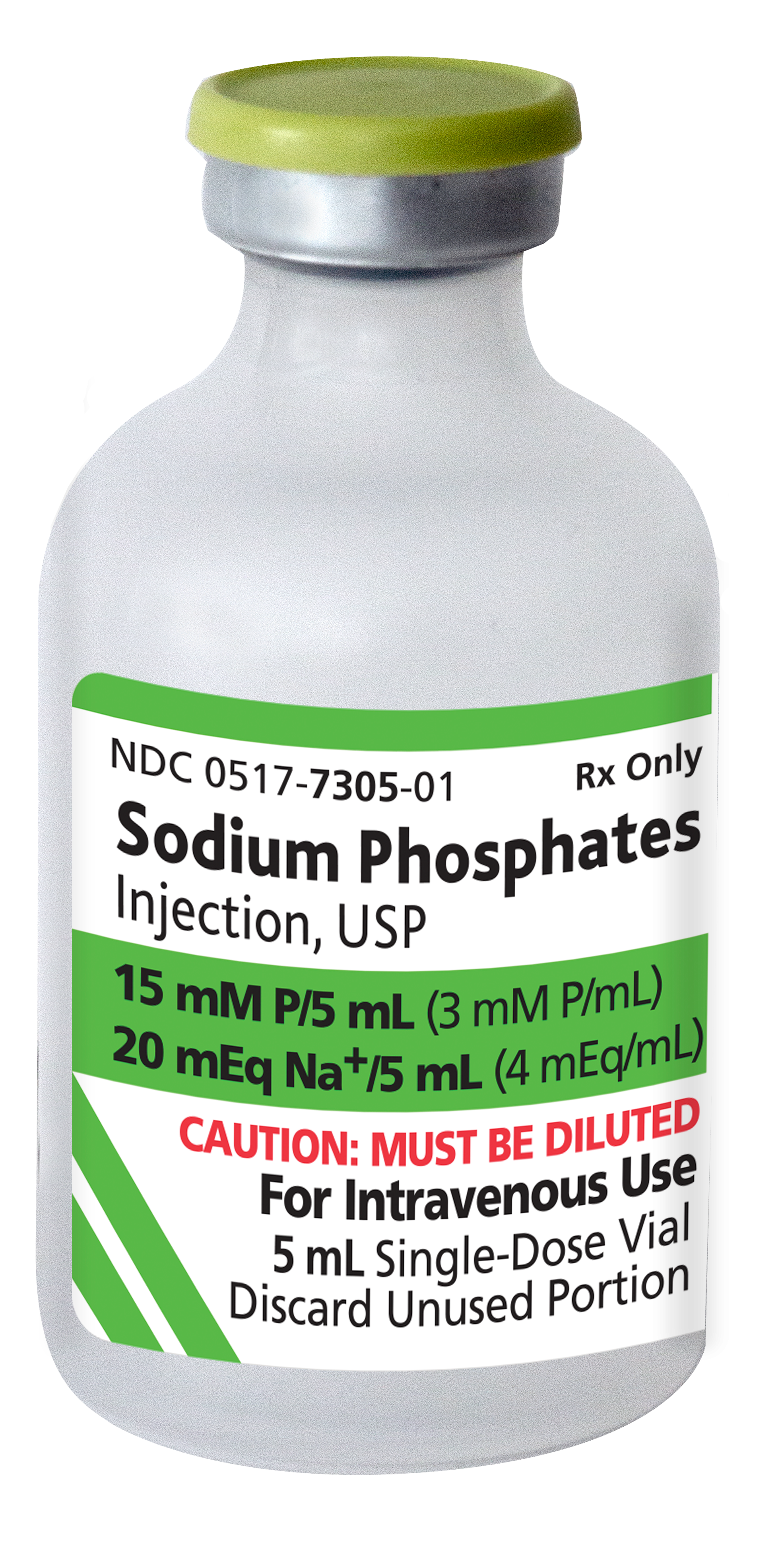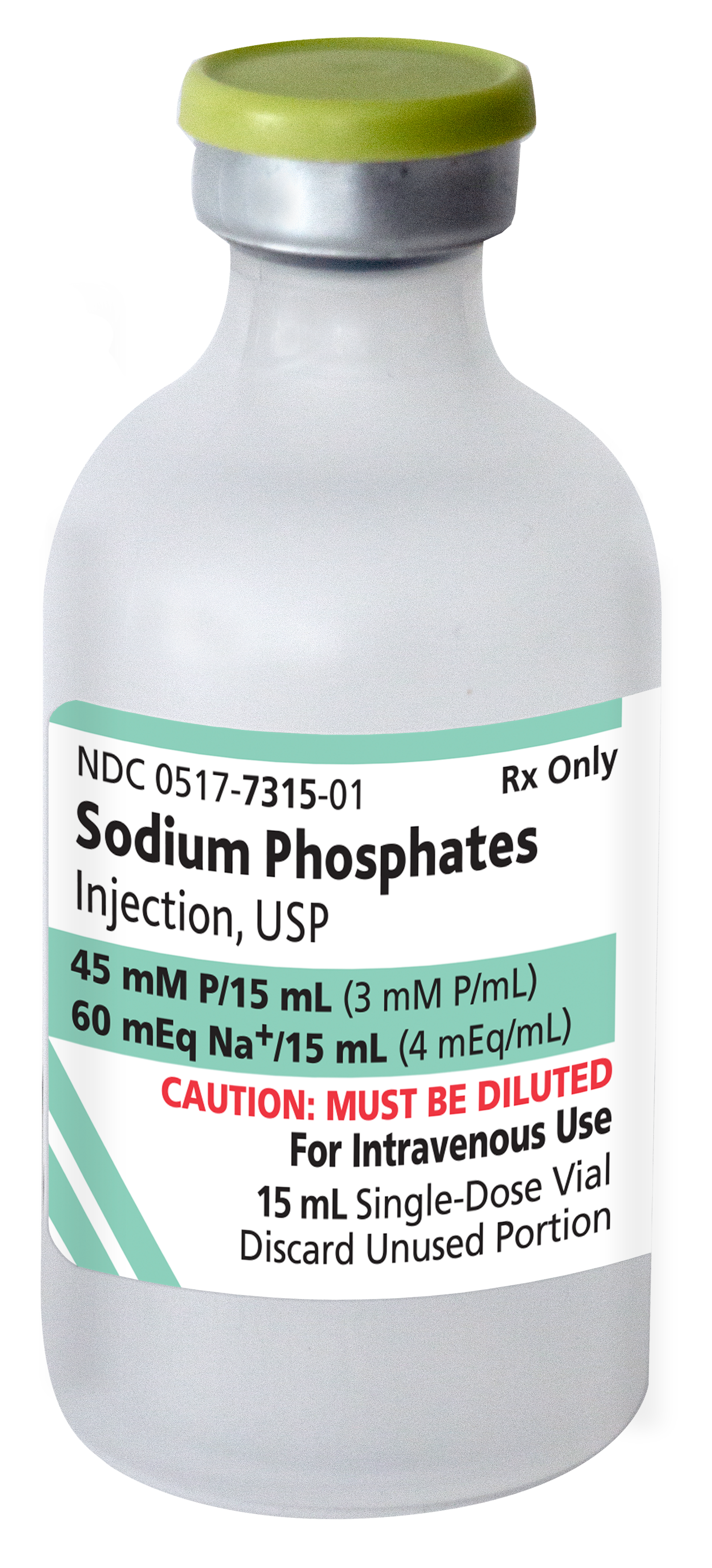Contact Us
By clicking Submit, you confirm that you accept our Privacy Policy and that you agree to your personal contact information being used to contact you and added to our database. If at any time you wish your personal information to be removed from the American Regent® database, please submit a message request to corpcommunications@americanregent.com.
CONTRAINDICATIONS
Sodium phosphate is contraindicated in diseases where high phosphorus or low calcium levels may be encountered, and in patients with hypernatremia.
WARNINGS
Sodium Phosphates Injection, USP 3 mM P/mL must be diluted and thoroughly mixed before use.
To avoid phosphorus intoxication, infuse solutions containing sodium phosphate slowly. Infusing high concentrations of phosphorus may result in a reduction of serum calcium and symptoms of hypocalcemic tetany. Calcium levels should be monitored.
Solutions containing sodium ions should be used with great care, if at all, in patients with congestive heart failure, severe renal insufficiency, and in clinical states in which there exists edema with sodium retention.
In patients with diminished renal function, administration of solutions containing sodium ions may result in sodium retention.
WARNING: This product contains aluminum that may be toxic. Aluminum may reach toxic levels with prolonged parenteral administration if kidney function is impaired. Premature neonates are particularly at risk because their kidneys are immature, and they require large amounts of calcium and phosphate solutions, which contain aluminum.
Research indicates that patients with impaired kidney function, including premature neonates, who receive parenteral levels of aluminum at greater than 4 to 5 mcg/kg/day accumulate aluminum at levels associated with central nervous system and bone toxicity. Tissue loading may occur at even lower rates of administration.
PRECAUTIONS
Do not administer unless solution is clear and seal is intact. Discard unused portion.
Phosphorus replacement therapy with sodium phosphate should be guided primarily by the serum phosphorus level and the limits imposed by the accompanying sodium (Na+) ion.
Use with caution in patients with renal impairment, cirrhosis, cardiac failure, and other edematous or sodium-retaining states.
Caution must be exercised in the administration of parenteral fluids, especially those containing sodium ions, to patients receiving corticosteroids or corticotropin.
Pregnancy: Animal reproduction studies have not been conducted with sodium phosphate. It is also not known whether sodium phosphate can cause fetal harm when administered to a pregnant woman or can affect reproduction capacity. Sodium phosphate should be given to a pregnant woman only if clearly needed.
Pediatric Use: The safety and effectiveness of sodium phosphate has been established in pediatric patients (neonates, infants, children, and adolescents).
Geriatric Use: An evaluation of current literature revealed no clinical experience identifying differences in response between elderly and younger patients. In general, dose selection for an elderly patient should be cautious, usually starting at the low end of the dosing range, reflecting the greater frequency of decreased hepatic, renal, or cardiac function, and of concomitant disease or other drug therapy.
Sodium ions and phosphorus are known to be substantially excreted by the kidney, and the risk of toxic reactions to this drug may be greater in patients with impaired renal function. Because elderly patients are more likely to have decreased renal function, care should be taken in dose selection, and it may be useful to monitor renal function.
ADVERSE REACTIONS
Adverse reactions involve the possibility of phosphorus intoxication. Phosphorus intoxication results in a reduction of serum calcium and the symptoms are those of hypocalcemic tetany.
OVERDOSAGE
In the event of overdosage, discontinue infusions containing sodium phosphate immediately and institute corrective therapy to restore depressed serum calcium and to reduce elevated serum sodium levels.
INDICATIONS AND USAGE
Sodium Phosphates Injection, USP 3 mM P/mL is indicated as a source of phosphorus, for addition to large volume intravenous fluids, to prevent or correct hypophosphatemia in patients with restricted or no oral intake. It is also useful as an additive for preparing specific parenteral fluid formulas when the needs of the patient cannot be met by standard electrolyte or nutrient solutions.
The concomitant amount of sodium (Na+ 4 mEq/mL) must be calculated into total electrolyte dose of such prepared solutions.
For additional safety information, please see Full Prescribing Information.
You are encouraged to report Adverse Drug Events to American Regent Inc. at 1-800-734-9236, or to the FDA by visiting www.fda.gov/medwatch or by calling 1-800-FDA-1088.
REF-2663 1/2024


